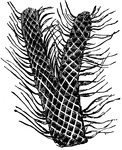Clipart tagged: ‘leaf-cushions’

Portion of Lepidodendron
This illustration shows a portion of Lepidodendron. Lepidodendron is the generic name of a large and…

This illustration shows a portion of Lepidodendron. Lepidodendron is the generic name of a large and…